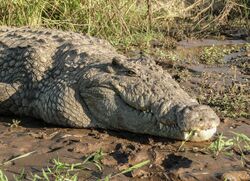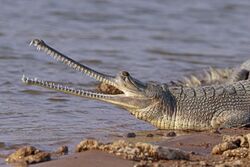Biology:Longirostres
| Longirostres | |
|---|---|

| |
| Nile crocodile (Crocodylus niloticus) | |

| |
| Gharial (Gavialis gangeticus) | |
| Scientific classification | |
| Domain: | Eukaryota |
| Kingdom: | Animalia |
| Phylum: | Chordata |
| Class: | Reptilia |
| Clade: | Archosauromorpha |
| Clade: | Archosauriformes |
| Order: | Crocodilia |
| Clade: | Longirostres Zittel, 1890 |
| Subgroups | |
| |
Longirostres is a clade of crocodilians that includes the crocodiles and the gavialids, to the exclusion of the alligatoroids. Defined in 2003 by Harshman et al., Longirostres is a crown group defined phylogenetically as including the last common ancestor of Crocodylus niloticus and Gavialis gangeticus and all of its descendants.[1]
Traditionally, crocodiles and alligators were considered more closely related and grouped together in the clade Brevirostres, to the exclusion of the gharials. This classification was based on morphological studies primarily focused on analyzing skeletal traits of living and extinct fossil species.[2] However, recent molecular studies using DNA sequencing have rejected Brevirostres upon finding the crocodiles and gavialids to be more closely related than the alligators.[1][3][4][5][6]
Below is a cladogram showing the relationships of the major crocodilian groups based on molecular studies:[5][6]
| Crocodylia |
| ||||||||||||||||||||||||||||||||||||||||||||||||||||||||||||||||||||||||
| (crown group) |
References
- ↑ 1.0 1.1 Harshman, J.; Huddleston, C. J.; Bollback, J. P.; Parsons, T. J.; Braun, M. J. (2003). "True and false gharials: A nuclear gene phylogeny of crocodylia". Systematic Biology 52 (3): 386–402. doi:10.1080/10635150309323. PMID 12775527. http://si-pddr.si.edu/bitstream/handle/10088/6275/2003C_Harshman_et_al.pdf.
- ↑ Holliday, Casey M.; Gardner, Nicholas M. (2012). Farke, Andrew A. ed. "A new eusuchian crocodyliform with novel cranial integument and its significance for the origin and evolution of Crocodylia". PLOS ONE 7 (1): e30471. doi:10.1371/journal.pone.0030471. PMID 22303441. Bibcode: 2012PLoSO...730471H.
- ↑ Gatesy, J.; Amato, G. (2008). "The rapid accumulation of consistent molecular support for intergeneric crocodylian relationships". Molecular Phylogenetics and Evolution 48 (3): 1232–1237. doi:10.1016/j.ympev.2008.02.009. PMID 18372192.
- ↑ Erickson, G. M.; Gignac, P. M.; Steppan, S. J.; Lappin, A. K.; Vliet, K. A.; Brueggen, J. A.; Inouye, B. D.; Kledzik, D. et al. (2012). Claessens, Leon. ed. "Insights into the ecology and evolutionary success of crocodilians revealed through bite-force and tooth-pressure experimentation". PLOS ONE 7 (3): e31781. doi:10.1371/journal.pone.0031781. PMID 22431965. Bibcode: 2012PLoSO...731781E.
- ↑ 5.0 5.1 Michael S. Y. Lee; Adam M. Yates (27 June 2018). "Tip-dating and homoplasy: reconciling the shallow molecular divergences of modern gharials with their long fossil". Proceedings of the Royal Society B 285 (1881). doi:10.1098/rspb.2018.1071. PMID 30051855.
- ↑ 6.0 6.1 Hekkala, E.; Gatesy, J.; Narechania, A.; Meredith, R.; Russello, M.; Aardema, M. L.; Jensen, E.; Montanari, S. et al. (2021-04-27). "Paleogenomics illuminates the evolutionary history of the extinct Holocene "horned" crocodile of Madagascar, Voay robustus" (in en). Communications Biology 4 (1): 505. doi:10.1038/s42003-021-02017-0. ISSN 2399-3642. PMID 33907305.
Wikidata ☰ Q107389342 entry
 |

